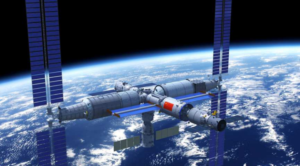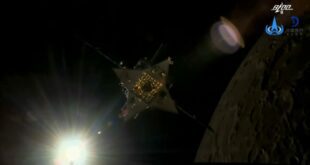
Chinese officials have unveiled details of, and launch timeline for, its Tiangong space station now that the Long March 5B launch vehicle has been successfully launched and China’s crewed capsule has been tested.
According to Chinese news media, the Tiangong space station will be completed by the end of 2022 and will orbit Earth at an altitude of 340 to 450 kilometres. Tiangong will operate for at least ten years and scientific, technological, and industry application experiments will be conducted on board.
The plan is to have three astronauts on board for six-month stints, and Tiangong will be able to accommodate up to six astronauts during crew transfers.
Tiangong will consist of three modules. Tianhe will be the core module that will provide the living quarters for the astronauts as well as the command and control centre for the space station. Meanwhile, the Tiangong-1 and Taingong-2 modules will be the space laboratories from which all experiments will be conducted.
The Tiangong space station will be T-shaped, with the Tianhe core module at the centre and the Tiangong-1 and Tiangong-2 laboratory modules on each side. Each module will have a mass of approximately 20 tonnes, and the entire orbital complex will have a combined mass of 66 tonnes.
The Tianhe will have two berth ports connecting to the Tiangong-1 and -2 space laboratory modules, three docking ports for crewed and cargo spacecraft, and an exit that will allow astronauts to conduct extravehicular activities.
The Tiangong space station has been designed to expand to a total of six modules if Chinese space officials deem it necessary and appropriate.
Perhaps the most impressive aspect of the Tiangong space station is the ambitious timeline and launch cadence for its completion. Chinese officials are planning eleven launches over a 24-month period starting in early 2021 in order to fully assemble the space station.
The first launch will loft the Tianhe core module on board a Long March 5B on early 2021. This will be followed by the launch of a crewed Shenzhou capsule followed by a Tianzhou cargo launch.
By 2023 both Tiangong-1 and Tiangong-2 space laboratory modules will be launched, along with three other crewed Shenzhou and a further three Tianzhou cargo launches.
Once the Tiangong space station has been fully assembled, the Xuntian space telescope will be launched and will be capable of docking with the crewed orbital complex for maintenance and repairs.
Finally, Chinese space officials have also announced that up to 18 new Chinese astronauts will be selected in July 2020. These men and women will be selected from the People’s Liberation Army Air Force (PLAAF) as well as civilians with exemplary scientific and engineering backgrounds and qualifications.





